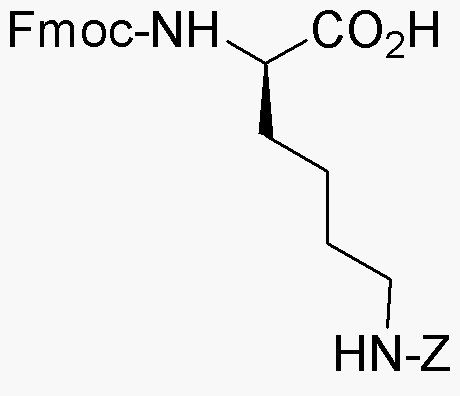Na-Fmoc-Ne-Z-D-lysine is widely utilized in research focused on:
- Peptide Synthesis: This compound serves as a key building block in the synthesis of peptides, allowing researchers to create complex structures for various applications in drug development.
- Bioconjugation: Its unique protective group facilitates the conjugation of peptides to other molecules, enhancing the delivery and efficacy of therapeutic agents in pharmaceutical applications.
- Protein Engineering: Used in the modification of proteins, it helps in studying protein interactions and functions, which is crucial for understanding biological processes.
- Drug Design: The compound's structure allows for the design of novel drugs that can target specific biological pathways, providing an advantage in developing more effective treatments.
- Research in Cancer Therapy: It is employed in the development of targeted therapies, where its ability to modify peptides can lead to more precise treatments with fewer side effects.
General Information
Properties
Safety and Regulations
Applications
Na-Fmoc-Ne-Z-D-lysine is widely utilized in research focused on:
- Peptide Synthesis: This compound serves as a key building block in the synthesis of peptides, allowing researchers to create complex structures for various applications in drug development.
- Bioconjugation: Its unique protective group facilitates the conjugation of peptides to other molecules, enhancing the delivery and efficacy of therapeutic agents in pharmaceutical applications.
- Protein Engineering: Used in the modification of proteins, it helps in studying protein interactions and functions, which is crucial for understanding biological processes.
- Drug Design: The compound's structure allows for the design of novel drugs that can target specific biological pathways, providing an advantage in developing more effective treatments.
- Research in Cancer Therapy: It is employed in the development of targeted therapies, where its ability to modify peptides can lead to more precise treatments with fewer side effects.
Documents
Safety Data Sheets (SDS)
The SDS provides comprehensive safety information on handling, storage, and disposal of the product.
Product Specification (PS)
The PS provides a comprehensive breakdown of the product’s properties, including chemical composition, physical state, purity, and storage requirements. It also details acceptable quality ranges and the product's intended applications.
Certificates of Analysis (COA)
Search for Certificates of Analysis (COA) by entering the products Lot Number. Lot and Batch Numbers can be found on a product’s label following the words ‘Lot’ or ‘Batch’.
*Catalog Number
*Lot Number
Certificates Of Origin (COO)
This COO confirms the country where the product was manufactured, and also details the materials and components used in it and whether it is derived from natural, synthetic, or other specific sources. This certificate may be required for customs, trade, and regulatory compliance.
*Catalog Number
*Lot Number
Safety Data Sheets (SDS)
The SDS provides comprehensive safety information on handling, storage, and disposal of the product.
DownloadProduct Specification (PS)
The PS provides a comprehensive breakdown of the product’s properties, including chemical composition, physical state, purity, and storage requirements. It also details acceptable quality ranges and the product's intended applications.
DownloadCertificates of Analysis (COA)
Search for Certificates of Analysis (COA) by entering the products Lot Number. Lot and Batch Numbers can be found on a product’s label following the words ‘Lot’ or ‘Batch’.
*Catalog Number
*Lot Number
Certificates Of Origin (COO)
This COO confirms the country where the product was manufactured, and also details the materials and components used in it and whether it is derived from natural, synthetic, or other specific sources. This certificate may be required for customs, trade, and regulatory compliance.


